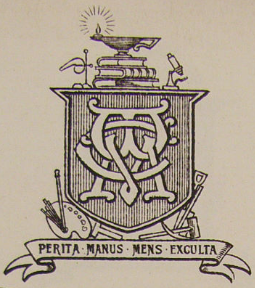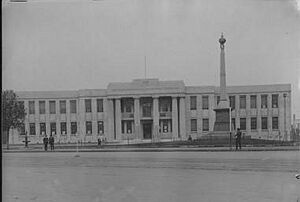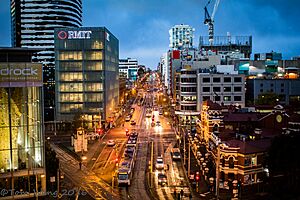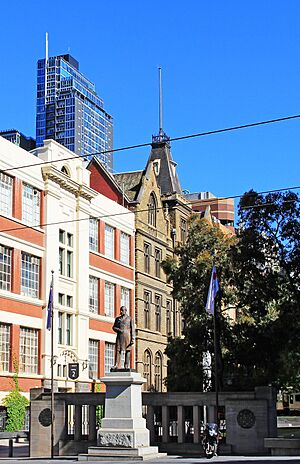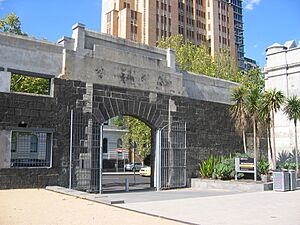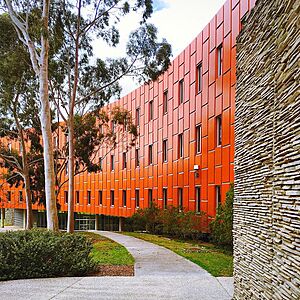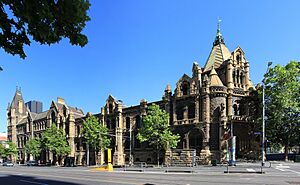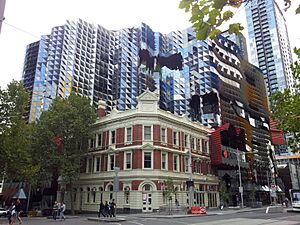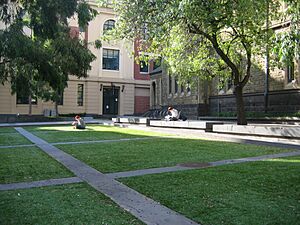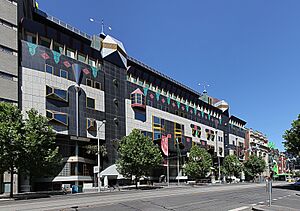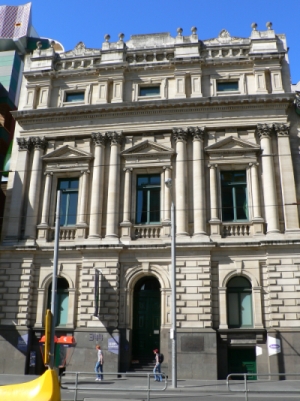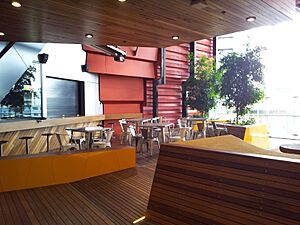Royal Melbourne Institute of Technology facts for kids
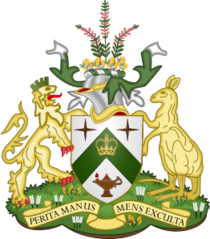
|
|
|
Other name
|
RMIT University |
|---|---|
|
Former names
|
|
| Motto |
Latin: Perita manus, mens exculta
|
|
Motto in English
|
"A skilled hand, a cultivated mind" |
| Type | Public research university |
| Established |
|
| Founder | Francis Ormond |
| Accreditation | TEQSA |
| Affiliation | Australian Technology Network (ATN) |
| Budget | A$1.62 billion (2023) |
| Visitor | Governor of Victoria |
| Chancellor | Peggy O'Neal |
| Vice-Chancellor | Alec Cameron |
|
Total staff
|
11,492 (2023) |
| Students | 91,544 (2023) |
| Undergraduates | 54,422 (2023) |
| Postgraduates | 13,553 coursework 2,558 research (2023) |
|
Other students
|
14,809 VE (2023) 4,355 SDENA (2022) 346 OUA (2023) 1,501 other (2023) |
| Location |
,
,
37°48′30″S 144°57′51″E / 37.8082°S 144.9643°E |
| Campus | Metropolitan with multiple sites |
| Colours | Red Blue |
| Nickname |
|
|
Sporting affiliations
|
|
| Mascot | Rupert the Redback Spider |
| Website | rmit.edu.au |
 |
|
The Royal Melbourne Institute of Technology, known as RMIT University, is a large public university in Melbourne, Australia. It was started in 1887 by Francis Ormond. RMIT is one of Australia's oldest universities. It is also a founding member of the Australian Technology Network, a group of leading technology universities.
RMIT began as a night school. It taught art, science, and technology. This was to help with the Industrial Revolution in Australia. For over 100 years, it was a private college. In 1992, it became a public university. Today, about 95,000 students study there. RMIT is known for its art and design programs. It is ranked 15th in the world for these subjects.
The main campus is in the heart of Melbourne. RMIT also has campuses in Brunswick and Bundoora. There are training sites at RAAF Williams base and Bendigo Airport. A research site is near Grampians National Park. Internationally, RMIT has campuses in Ho Chi Minh City and Hanoi, Vietnam. It also has teaching partnerships in other Asian countries. In Europe, it has a research center in Barcelona, Spain.
Contents
How RMIT University Started
Early Beginnings (Before 1887)
RMIT's first name was the Working Men's College of Melbourne. It was founded by Francis Ormond in the 1880s. Ormond was a Scottish-born farmer and politician. He planned the college based on similar schools in London.
Ormond gave £5,000 to start the college. Other people in the Victorian Parliament supported him. Workers' unions in Melbourne also helped. They encouraged their members to donate money. The Victorian Government gave the land for the college. It was located near the State Library of Victoria.
Working Men's College (1887–1960)
The Working Men's College of Melbourne opened on June 4, 1887. It was the fifth college in Victoria. On its first night, 320 students enrolled.
It started as a night school. It taught "art, science and technology" to working men. Ormond believed education could change lives. He thought the college would help Melbourne's industries grow. In 1904, it became a private college.
Between 1900 and the 1930s, the college grew. It built new schools for art, engineering, and radio. It also helped Australia's war efforts. It trained soldiers returning from World War I. In 1934, its name changed to Melbourne Technical College.
The college helped a lot during World War II. It trained many military personnel. This included most of the Royal Australian Air Force's communication officers. It also trained 2,000 civilians to make ammunition. The Australian Government asked it to make aircraft parts. It made most parts for the Beaufort Bomber.
Becoming RMIT (1960–1992)
After World War II, in 1954, the college received a special honor. Queen Elizabeth II gave it "royal patronage." This was for its service to education and the war effort. It was renamed the "Royal Melbourne Technical College." It is the only Australian university with the "Royal" prefix.
Its name changed to the Royal Melbourne Institute of Technology in 1960. In the mid-1900s, it started offering both higher education and vocational training. It also began working with countries in Southeast Asia. In 1979, the Emily McPherson College joined RMIT.
RMIT University (1992–Present)
On July 1, 1992, RMIT merged with Phillip Institute of Technology. It became a public university. This happened under a special law by the Victorian Government. Its name changed to RMIT University.
In the 1990s, the university grew quickly. It joined with other colleges. The Melbourne College of Decoration and Design joined in 1993. The Melbourne College of Printing and Graphic Arts joined in 1995. That same year, it opened a new campus in Bundoora. In 1999, it got the Melbourne Institute of Textiles campus in Brunswick.
Around 2000, the Vietnamese Government invited RMIT. They wanted it to be Vietnam's first foreign-owned university. Its first international campus opened in Ho Chi Minh City in 2001. A second one opened in Hanoi in 2004. In 2013, RMIT opened a center in Barcelona, Spain.
RMIT Campuses
Australia
Melbourne City Campus
The City campus is in the center of Melbourne. It is RMIT's oldest and largest campus. It is known for its modern buildings. It also has well-preserved old buildings.
The City campus started in 1887. Its first building is on the corner of Bowen Street and La Trobe Street. The campus has grown to 87 buildings. It does not have walls around it. Its buildings blend in with the city. Most buildings cover six city blocks. The campus is near the State Library of Victoria. It is also close to Melbourne Central railway station. Trams serve the campus well.
The area around Bowen Street and La Trobe Street was once a justice area. Some old buildings from that time are still used by the university. The Old Melbourne Gaol's cell block is now a museum. Its old chapel is now a multi-faith worship place. The former Melbourne City Watchhouse is also a museum. The old Magistrates' Court now holds university offices.
Other important buildings include Storey Hall (1887), Capitol Theatre (1924), and Swanston Academic Building (2012).
Bundoora Campus
The Bundoora campus opened in 1992. It is about 18 km from the City campus. It is divided into 'East' and 'West' by Plenty Road. Unlike the city campus, Bundoora West is set in a large parkland.
This campus offers programs in aerospace engineering, electrical engineering, and medical sciences.
Brunswick Campus
The Brunswick campus joined RMIT in 1999. It is for vocational design schools. It is 6 km from the City campus. Before RMIT, it was the Melbourne Institute of Textiles campus.
Programs here include product design, fashion design, and graphic design.
Other Australian Sites
RMIT's flight training is at the Royal Australian Air Force's Williams base. This base is 20 km from the City campus. It is the world's oldest operating air force base.
The university also has a research site in Hamilton. This is 300 km west of the City campus. It focuses on issues in rural areas.
Asia
Ho Chi Minh City Campus
In 1998, the Vietnamese Government invited RMIT. They wanted it to open the country's first foreign-owned university. In 2001, RMIT bought and restored an old French building. This building is in District 3, Ho Chi Minh City. Students call it "the Castle."
The main Ho Chi Minh City campus is in the Phu My Hung area. The first buildings opened in 2005. In 2011, recreation and student housing opened.
Hanoi Campus
The Hanoi campus started in 2004. It was first in the Van Phuc Diplomatic Compound. In 2007, it added another building. In 2010, it moved to a new tower overlooking Ngọc Khánh Lake.
Other Asian Partners
RMIT also teaches or approves programs for other schools. These include the Hong Kong Art School and Shanghai Institute of Foreign Trade in China. Also, SIM Global Education in Singapore and Taylor's University in Malaysia.
Europe
Barcelona Centre
In 2013, RMIT opened a center in Barcelona, Spain. This center works with European partners. It offers a double master's degree in architecture. This helps RMIT students work on the Sagrada Família basilica.
How RMIT is Organized
RMIT University is a public university. It was created by the Victorian Government. It is managed by the RMIT Council and the RMIT Chancellery.
Divisions and Schools
RMIT has two main parts: Higher Education and Vocational Education and Training (VET). These parts oversee 17 academic schools. The schools are grouped into three colleges. Higher education schools offer degrees. VET schools offer certificates and diplomas.
University Council
RMIT is led by a council of 21 members. This council guides the university. The RMIT Chancellor leads the council. The vice-chancellor and president is also on the council.
Five members of the council are chosen by students and staff. Other members are chosen by the Chancellor or council members. These members must be experts in education or finance.
Vice-Chancellor
The RMIT Council gives power to the vice-chancellor and president. This person is the chief executive of the university. They are in charge of all academic and administrative matters.
Academic Board
The RMIT Academic Board decides what is needed to get a degree. The board includes the RMIT Chancellery. It also has up to 46 other members. Most of these are chosen by staff and students.
Colleges and Schools
RMIT has four academic colleges:
- College of Business and Law
- RMIT School of Accounting, Information Systems and Supply Chain
- RMIT School of Economics, Finance and Marketing
- RMIT School of Graduate Business and Law
- RMIT School of Management
- College of Design and Social Context
- RMIT School of Architecture and Urban Design
- RMIT School of Art
- RMIT School of Design
- RMIT School of Education
- RMIT School of Fashion and Textiles
- RMIT School of Global, Urban and Social Studies
- RMIT School of Media and Communication
- RMIT School of Property, Construction and Project Management
- STEM College (Science, Technology, Engineering, and Math)
- RMIT School of Computing Technologies
- RMIT School of Engineering
- RMIT School of Health and Biomedical Sciences
- RMIT School of Science
- College of Vocational Education
- RMIT School of Vocational Business Education
- RMIT School of Vocational Engineering, Health and Sciences
RMIT Businesses
"RMIT Group" is the university's business part. It includes companies owned by RMIT University.
- RMIT Training: This includes:
- Informit (for online publications). It runs a large online database of research.
- RMIT University Press (for print publications).
- RMIT English Worldwide.
RMIT also has international companies. These include RMIT Spain (RMIT Europe) and RMIT Vietnam.
Academic Achievements
University Rankings
| University rankings | |
|---|---|
| QS World | 125 |
| ARWU World | 301–400 |
| US News World | 198 |
| Australian rankings | |
In 2024, RMIT was ranked #199 globally. This ranking combines results from QS, THE, and ARWU. It was 14th among Australian universities.
The Australian Financial Review ranked RMIT #23 among Australian universities in 2024.
Globally, RMIT is highly ranked:
- In 2025, Quacquarelli Symonds ranked it #125 worldwide. It was 10th in Australia.
- In 2024, Times Higher Education ranked it #251–300 worldwide. It was tied for 14–19th in Australia.
- In 2024, Academic Ranking of World Universities ranked it #301–400 worldwide. It was tied for 16–21st in Australia.
- In 2025–2026, U.S. News & World Report ranked it #198 worldwide. It was 14th in Australia.
- In 2024, CWTS Leiden Ranking ranked it #239 worldwide. It was 11th in Australia.
Student Success
The Australian Government surveys students. These surveys look at student experience and job outcomes.
- In 2023, employers were very happy with RMIT graduates. The satisfaction rate was 84.7%.
- In 2023, 71.8% of undergraduate students found full-time jobs. For postgraduate students, it was 98%.
- Undergraduates earned about A$66,800 to start. Postgraduates earned about A$98,000.
- In 2023, undergraduates rated their education quality at 73.9%. Postgraduates rated theirs at 77.9%.
Research at RMIT
RMIT focuses on practical research. It works with government and industries. Its research areas include design, technology, health, and sustainability.
RMIT has a special research school. Over 50 research centers also work within RMIT's colleges.
Collections and Galleries
Libraries
RMIT Library is the main library system. It has four locations in Australia. Swanston Library is the largest. It is in Building 8 at the City campus. It is one of Melbourne's top libraries. Other libraries are in Brunswick and Bundoora.
The City campus is also close to the State Library of Victoria. This is Melbourne's largest public library.
RMIT schools also have their own special collections. Examples include the AFI Research Collection and RMIT Design Archives.
RMIT's Vietnam campuses have two libraries. The Beanland Library is in Ho Chi Minh City.
Online Resources
You can find RMIT research online. The RMIT Research Repository has articles and papers. These are indexed by Google Scholar and WorldCat.
RMIT Training also runs the Informit online database. This is the largest research database for Australia and Asia-Pacific.
Art Galleries
RMIT Gallery is the university's main public art gallery. It is at the City campus. It shows Australian and international art. It focuses on modern art and design. It is in the historic Storey Hall.
RMIT First Site Gallery is also at the City campus. It shows work by new artists. It is located below RMIT Gallery. The Artland program at the Brunswick campus shows student design work.
Many RMIT schools also have their own galleries. These include the School of Art's galleries and the School of Architecture and Design's Design Hub Gallery.
Art Collection
RMIT Gallery takes care of RMIT's art collection. This includes the Lindsay Edward Collection of fine art. It has works by famous Australian artists. Many of these artists studied or taught at RMIT.
Student Life
RMIT Link (Campus Union)
RMIT Link helps students with social, cultural, and sports activities. It has two parts: Arts & Culture and Sports & Recreation.
Arts & Culture offers workshops and funding for art projects. It also has a free cinema program.
Sports & Recreation manages the university's sports teams, called the Redbacks. It helps fund student sports clubs. It also runs the City campus gym.
RUSU (Student Union)
RMIT's University Student Union (RUSU) represents students. It was founded in 1944. RUSU works to protect student rights. It also supports student clubs and societies.
RUSU Departments:
- Activities – plans events and parties.
- Campuses – represents students on campus matters.
- Clubs and societies – supports student groups.
- Education – campaigns on education issues.
- Environment – promotes environmental care.
- International Students – helps international students.
- Postgraduate Students – represents students doing higher degrees.
- Queer – supports the LGBT community.
- Women's – supports women's rights.
- Realfoods – RUSU's organic vegetarian cafe.
Student Media:
- The Swanston Gazette – A student newspaper started in 2019.
- Catalyst – A free student magazine since 1944.
- RMITV – A student television company since 1987.
- Student Youth Network (SYN) – A student radio station.
- 3RRR – RMIT's former radio station, now independent.
Student Housing
RMIT has several student housing options. These include RMIT Village and College Square. They are apartment complexes where students cook for themselves.
Some colleges at the nearby University of Melbourne also have spots for RMIT students. These colleges offer meals and support.
Student Diversity
In 2014, 54% of RMIT students were male and 46% were female.
Spiritual Centre
RMIT's Spiritual Centre is a multi-faith worship place. It is on the City campus. It is in the historic Old Melbourne Gaol chapel, built in 1860. The center welcomes all staff and students. It has chaplains for different faiths.
People of RMIT
RMIT graduates are known for being very employable. In 2011, RMIT was ranked 51st globally for graduate employability. In 2011, about 280,000 graduates lived in 130 countries.
Famous people who attended or graduated from RMIT include:
- Lydia Lassila: Australian skier and Olympic gold medalist.
- Jim Stynes: Irish Australian rules footballer.
- James Wan: Australian film director.
- Travis Fimmel: Australian actor.
- James Tomkins: Australian rower and Olympic gold medalist.
- Rove McManus: Australian comedian and TV host.
- Andrew Stockdale: Singer from the band Wolfmother.
- Judith Durham: Australian singer.
- Mai Phương Thúy: Vietnamese actress and Miss Vietnam 2006.
- John Safran: Australian documentary maker.
- Charles Billich: Australian artist.
- Felix Colgrave: Australian animator.
- Greig Fraser: Director of photography.
- Maryam Al Zadjali: Director of the Omani Society for Fine Arts.
Graduation Traditions
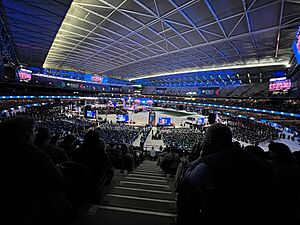
RMIT has a special graduation parade. Graduates and faculty march from the City campus. They walk down Swanston Street to Federation Square. The Lord Mayor of Melbourne welcomes them. The mayor gives permission for the ceremony to continue. The graduation ceremony takes place at Docklands Stadium.
See also
- List of universities in Australia



